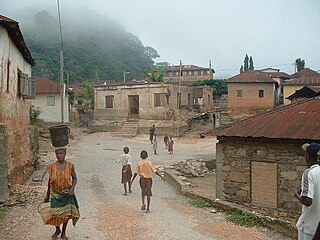Related Research Articles

The Kwa languages, often specified as New Kwa, are a proposed but as-yet-undemonstrated family of languages spoken in the south-eastern part of Ivory Coast, across southern Ghana, and in central Togo. The name was introduced 1895 by Gottlob Krause and derives from the word for 'people' (Kwa) in many of these languages, as illustrated by Akan names.
The Adele language is spoken in central eastern Ghana and central western Togo. It belongs to the geographic group of Ghana Togo Mountain languages of the Kwa branch of Niger–Congo. The speakers themselves, the Adele people, call the language Gidire.

Mòcheno is an Upper German variety spoken in three towns of the Bersntol, in Trentino, northeastern Italy.
The Southern Nilotic languages are spoken mainly in western Kenya and northern Tanzania. They form a division of the larger Nilotic language family, along with the Western Nilotic languages and the Eastern Nilotic languages.
The Kalenjin languages are a family of a dozen Southern Nilotic languages spoken in Kenya, eastern Uganda and northern Tanzania. The term Kalenjin comes from an expression meaning 'I say ' or 'I have told you'. Kalenjin in this broad linguistic sense should not be confused with Kalenjin as a term for the common identity the Nandi-speaking peoples of Kenya assumed halfway through the twentieth century; see Kalenjin people and Kalenjin language.
Pökoot is a language spoken in western Kenya and eastern Uganda by the Pokot people. Pökoot is classified to the northern branch of the Kalenjin languages found in Kenya, Uganda, and Tanzania. The Pökoot are usually called "Kimukon" by the other Kalenjin peoples. A 1994 figure of SIL puts the total number of speakers at 264,000, while the only little more recent Schladt (1997:40) gives the more conservative estimate of 150,000 people, presumably based on the figures found in Rottland (1982:26) who puts the number at slightly more than 115,000.
Logba is a Kwa language spoken in the south-eastern Ghana by approximately 7,500 people. The Logba people call themselves and their language Ikpana, which means ‘defenders of truth’. Logba is different from Lukpa of Togo and Benin, which is also sometimes referred to as Logba.
The Grũsi languages, or Gurunsi languages, are a group of Gur languages, comprising about 20 languages spoken by the Gurunsi peoples. The Grũsi languages are spoken in northern Ghana, adjacent areas of Burkina Faso and Togo. The largest language in the Grusi group is Kabiye, a language spoken by approximately 1.2 million people throughout central Togo.

The Ghana–Togo Mountain languages, formerly called Togorestsprachen and Central Togo languages, form a grouping of about fourteen languages spoken in the mountains of the Ghana–Togo borderland. They are part of the Kwa branch of the Niger–Congo family.
Animere is a language spoken in Ghana, in the Kecheibe and Kunda villages of the Benimbere people. It is most closely related to Kebu or Akebu of Togo. Both are Ghana Togo Mountain languages (GTM), classified as members of the Ka-Togo group by Heine (1968). Like most other GTM languages, Animere is a noun-class language.
Siwu is spoken in the mountainous central part of the Volta Region of Ghana. It belongs to the geographic group of Ghana Togo Mountain languages of the Kwa branch of Niger–Congo. The speakers of Siwu call themselves the Mawu and their land Kawu.
Mogum is an Afro-Asiatic language spoken in south central Chad. Speakers are found in Sorki canton in Chinguil sub-prefecture.
The Nimbari language, which is no longer spoken, was a member of the Leko–Nimbari group of Savanna languages. It was spoken in northern Cameroon. Ethnologue lists Badjire, Gorimbari, and Padjara-Djabi villages as Nimbari locations in Bénoué and Mayo-Louti divisions.

The Jukunoid languages are a branch of the Central Nigerian languages spoken by the Jukun and related peoples of Nigeria and Cameroon. They are distributed mostly throughout Taraba State, Nigeria and surrounding regions.
Akebu or Kebu is one of the Ghana–Togo Mountain languages spoken by the Akebu people of southern Togo and southeastern Ghana. It is a tonal language with nominal classes. Akebu is closely related to the Animere language.
Jaikó is an extinct language of southeastern Piauí, Brazil.
Likpe or Sekpele is spoken in the mountainous central part of the Volta Region of Ghana. It belongs to the geographic group of Ghana Togo Mountain languages of the Kwa branch of Niger–Congo.
Lelemi or Lefana is spoken by the Buem people in the mountainous Volta Region of Ghana. It belongs to the geographic group of Ghana Togo Mountain languages of the Kwa branch of Niger–Congo.
Ma, also known as A-Ma-Lo, Amadi, Madi, Madyo, is a Ubangian language spoken in Haut-Uele Province, the Democratic Republic of Congo.
Sabujá (Sapoya), or Pedra Branca, is an extinct Karirian language of northeastern Bahia, Brazil. It is sometimes considered a dialect of a single Kariri language.
References
- Heine, Bernd (1968) Die Verbreitung und Gliedering der Togorestsprachen (Kölner Beiträge zur Afrikanistik vol. 1). Köln: Druckerei Wienand.
- Seidel, A. (1898) 'Beiträge zur Kenntnis der Sprachen in Togo. Aufgrund der von Dr. Rudolf Plehn und anderen gesammelten Materialien bearbeitet.' Zeitschrift für Afrikanischer und Oceanischer Sprachen, 4, p. 286.
- Westermann, Diedrich Hermann (1922) 'Vier Sprachen aus Mitteltogo. Likpe, Bowili, Akpafu und Adele, nebst einigen Resten der Borosprache. Nach Aufnahmen von Emil Funke und Adam Mischlich bearbeitet'. Mitteilungen des Seminars für Orientalische Sprachen, 25, 1-59.
| This article about Niger–Congo languages is a stub. You can help Wikipedia by expanding it. |